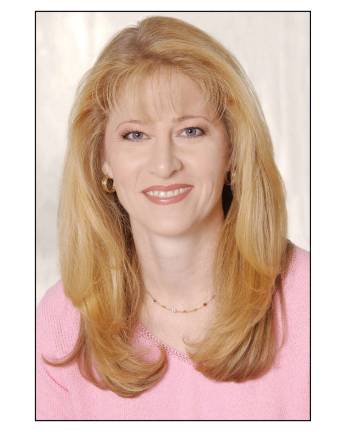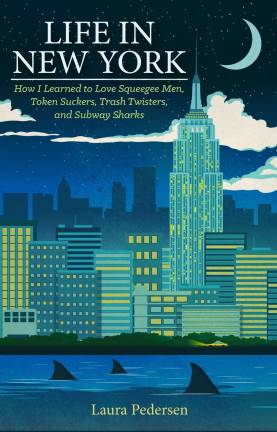New York City History Gets Personal


Laura Pedersen came to New York City in 1984, at a time when people carried wallets filled with mugger money and Central Park was home to dope peddlers. Renters looked for apartment ads in The Village Voice and a pizza slice and a subway ride both cost 75 cents.
In her book, “Life in New York: How I Learned to Love Squeegee Men, Token Suckers, Trash Twisters, and Subway Sharks,” she also revisits the history of the city dating back to 1626 when Manhattan was bought from the Indians as a 24-dollar trade. And because her grandfather came here in the 1920s and her father was born here in the decade that followed, she provides us with secondhand accounts of events like her grandfather watching the Empire State Building being constructed and her father riding the elevated railway above Third Avenue.
A Buffalo native, Pedersen began her career here as the youngest person with a seat on the American Stock Exchange. Throughout her 30 years in Manhattan, she has built quite an impressive and varied resume. Besides penning 15 books, she worked on The Joan Rivers Show as Rivers’ assistant and her play “The Brightness of Heaven” ran at the iconic Cherry Lane Theatre last year.
You got a job at the Stock Exchange when you were 20. How did that come about?I left the Buffalo area — we were in a very bad recession and unemployment was worse in Buffalo than the rest of the country. Opportunities in New York City were better. I called to see if they were hiring entry-level positions at the Stock Exchange and they were. And I applied for one. It was just putting cards in a machine all day long. The reporters would mark them. And when I put a card in the machine, it would send the information to go on the ticker tape all around the world. I felt like such a cog in the wheels of international finance. If I didn’t put that card in, that trade wouldn’t go up on a ticker tape around the world. It was a lot of responsibility.
You wrote about that experience in your first book, “Play Money,” and it revealed that you eventually became a millionaire. Yeah, that always seemed a bit much. That was kind of a favorite headline which was never my first choice. I managed to go to Wall Street at the beginning of the biggest bull market in history, which I had no idea I was doing. I got there in 1984 and if you look at a chart, stocks started going up after that. It was dumb luck ... I was not the first woman to have a seat, but I knew her and she had just gotten it a few years before. She was the first woman and I was the youngest.
How did you research the history of the city?Well I have this connection that my grandfather had come to New York City in the 1920s. And my father was born there in the 1930s. And my grandfather remained, so they were this great connector back almost 100 years. ... My grandfather would tell me about working in New York in the 1920s and ‘30s and on Long Island in the ‘50s and what it was like. My dad went to school in Manhattan and was drafted into the Army during the Korean War. They were my connections to the past and laid the groundwork. And my dad would talk about the old Penn Station and my grandfather would talk about living on a nickel a day. He laughed so hard about the book on New York on five dollars a day, which was popular in the ‘80s. He said, “Oh, I did much better than that.” And he watched the Empire State Building go up. He’d have lunch or dinner out there when he was working in the restaurant or when he had a couple days of unemployment. I put this in the book, they would use the Indian tribes who were not very afraid of heights and he talked to one of them. And the man said, “We’re just as scared as the next person, but we take a lot of pride in our ability to do this.” And then the guy pointed up and said, “See that guy over there in the red shirt? That’s a woman. Her husband is sick and he doesn’t want to lose this job.”
You wrote that the Second Avenue subway project actually began in 1920.It’s been a work-in-progress for almost 100 years now. And when you look at China building five or ten expensive subways all in one year, it does make us look down at our feet. But, as I said, a lot of people say, “New Yorkers don’t like children. It’s not a child-friendly city.” And I say, “We love children. We’re building a subway for our children’s children.” I doubt I’ll ever get to ride the Second Avenue subway. And yeah, my whole neighborhood has been torn up for years now. All my favorite restaurants have been forced to close down. And we’re suffering because that’s how much we love children.
In your section on the plethora of parades here, you speak of the Danish Day Parade that you created.Yeah, we don’t get a parade! I guess we’re just too small a country. I could see a big LEGO float, couldn’t you? It started because I grew up in Buffalo where we have one of the biggest St. Patrick Day Parades in the country and one of the biggest Pulaski Day Parades in the country. So I said to my dad when I was little, because he’s first generation, his parents were both born in Copenhagen, Denmark, when’s our parade? He said, “It’s just us, when we walk out of the house, it’s a parade.” When I got to New York City, everybody had a parade, there were hundreds of parades. And yet, we still didn’t have one. So I go up to church one Sunday every summer with my Danish flag, Danish butter cookies and Danish stickers and tell everybody, “It’s the Danish Day Parade today.”
What was it like to work with Joan? I have a background in standup comedy, so I really enjoyed working with her on material. She had a meticulous file cabinet. You have to remember, she was a comedian before the internet and computers. We were in the process of translating onto the computer, but in the old days the jokes were all on 3 by 5 cards in these enormous file cabinets and they were all triple referenced. You know, jokes about Elizabeth Taylor would be under “fat,” “Elizabeth Taylor” and “celebrities.” I worked with a lot of comedians and many of the good ones don’t write much of their own material, but she did. She was very bright and graduated at the top of her class. On the weekends, she wasn’t actually watching reality shows, she was watching documentaries on the Civil War or whatever new 800-page nonfiction book that came out, she’d be the first to have that. She broke so many doors for women comedians, whether you like her style or not ... I just give her a lot of credit. She worked through a tremendous amount of adversity and sexism. And the fact that she didn’t get the Mark Twain Prize for American Humor, I wrote a couple of letters to them. I said that she paved the way. When they gave it to Tina Fey a couple of years ago, I said, “That’s great. She’s a very deserving young woman who has a great future ahead of her. But let’s give it to Joan Rivers, who made a lot of that possible.” She was a nice lady. When my grandfather was in the hospital she sent flowers and signed it “Joan Rivers.” Now, in her personal correspondence at the time, her husband had just recently died, so she still used “Joan Rosenberg.” The reason she sent those flowers was so all the nurses at that station would see flowers from Joan Rivers, think that he was someone important, and give him the best care possible.
www.laurapedersenbooks.com